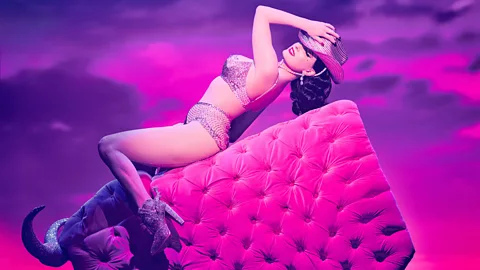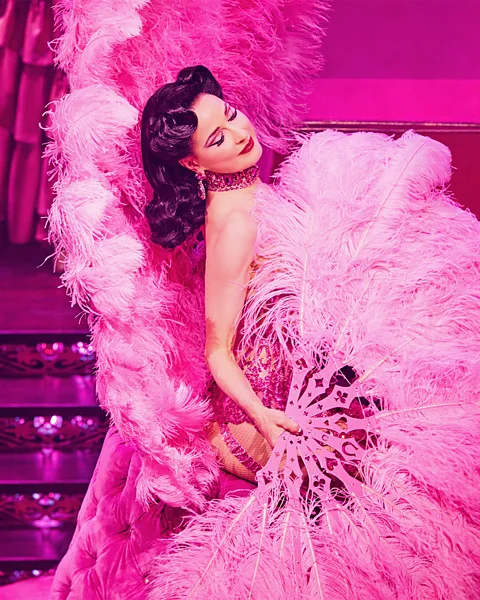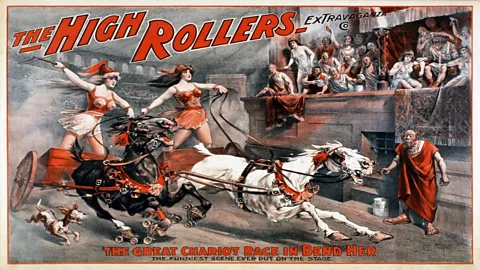'It makes me feel strong': Burlesque is back - but is it empowering or degrading to women?
 Chris Davis Studio
Chris Davis StudioAs burlesque queen Dita Von Teese puts on a new London show, the art form, which blends glamour, striptease and humour, is having a moment again – but the debate around it continues.
Grab your nipple pasties and tip your bowler hat: burlesque is back. The art form, which blends vintage glamour, coquettish striptease, and a winking knowingness, is one that seems to blow in-and-out of fashion: it was huge in the 2000s, then faded from view. "When it's needed as a discursive form, it comes up," says Jacki Wilson, associate professor of performance and gender at the University of Leeds. And while in recent years, in the UK at least, drag has replaced burlesque as the trending cabaret act de jour, a couple of big new shows suggest burlesque might just be slinking back into the spotlight.
"I think it's having a true renaissance, actually – all over the world," burlesque performer Tosca Rivola tells the BBC. She'd know: her show Diamonds and Dust, a "narrative" burlesque show starring Dita Von Teese, has just opened in London. And while Von Teese may be the enduring queen of the art form, even she benefited from the Taylor Swift effect recently, being introduced to a new audience when she starred as a fairy godmother in the video for the singer's 2022 single Bejeweled. Also about to open in the West End is Burlesque the Musical – a stage version of the Christina Aguilera and Cher-starring 2010 film, while at Edinburgh's globally-renowned Fringe Festival this summer, a new International Burlesque Festival is set to run across five venues for the whole month, in response to a "major increase in burlesque productions staged at the Fringe" last year, according to organisers. And if an ultra-glam version of burlesque has endured more in the US than the UK over the last 15 years, it's also enjoying something of a renaissance there. When a Met Gala after-party centres around a burlesque performance by Teyana Taylor and FKA Twigs, as it did this year, it's clearly more hot ticket than old hat.
 Chris Davis Studio
Chris Davis StudioOr is it? Many of these offerings feel doubly retro: a throwback 20 years to the last mainstream period of an art form that was already harking back to a different era. Is the revival of interest in burlesque actually part of a broader wave of specifically millennial nostalgia? Burlesque the Musical is clearly targeting the same millennial audiences who have flocked to other movie-to-musical adaptations such as Cruel Intentions, Mean Girls, Legally Blonde and Clueless. And the fact that Von Teese is still the big draw for Diamonds and Dust suggests a looking back rather than any great leap forward. Glancing at social media, there is plenty of burlesque on Instagram and TikTok, but not too much evidence of Gen Z rediscovering or reinventing it just yet.
A short history of burlesque
Before we get lost in such layered timelines, here's a brief history. Burlesque's origins are in Victorian Britain: it grew out of music hall and vaudeville. When Lydia Thompson's troupe The British Blondes visited New York in 1868, their combination of parody, humour, singing, dancing and revealing costumes caused a sensation. "Burlesque is foundationally revolutionary feminist – a reclaiming of female sexuality," Kay Siebler, assistant professor at the University of Nebraska Omaha, tells the BBC. "The root, 'burle', is Italian, and means satire, and burlesque was originally created by women's suffrage performers whose whole objective was taking up public space, and not being confined by patriarchal ideas of what it means to be a woman." But from there, American burlesque developed into its own thing, the emphasis gradually moving towards striptease. There's also, it should be said, a parallel story of the art form's development across Europe, notably in the cabaret clubs of Paris and Berlin, towards the end of the 19th Century.
Fast-forward to the 1990s, and neo-burlesque was born in the US. By the mid-2000s, hastened by films such as Moulin Rouge and Chicago, burlesque helped drive a wider trend for vintage glamour, and dominated the stages of cabaret clubs across the globe – as an art form made by women, for women. "Throughout the 90s, I was very much under the hetero male gaze," Dita Von Teese tells the BBC, as she reflects on a career which started in strip clubs. "But I'd say around 2002 my fan base shifted to very female… I think because [burlesque] resonated with people, and they felt like they had some kind of permission to indulge in glamour and embrace their sensuality."
As an elder millennial, I remember this era well; long strings of pearls, fishnet stockings, corsets and feathery headbands still shriek mid-2000s as much as they evoke the belle epoque to me. By 2007, burlesque was mainstream enough that one of the first pieces I ever wrote for a newspaper was covering an amateur burlesque night in a small town in Wales that had faintly scandalised the locals. Because the more popular burlesque got, the more it was scrutinised, with increasing debate over whether it was a really an art form or mere titillation. Some argued: weren't women prancing around in corsets, stockings and suspenders just embodying old, patriarchal norms – stripping with pretensions?
 Getty Images
Getty ImagesIt's worth restating Von Teese's point that neo-burlesque was created and performed by women, for audiences of women and gay men; it might have been using the language of classic heterosexual desire, but it became a safe space for embodying and playing with that. And a really significant strand of neo-burlesque took that further – or rather, went back to its radical roots. There's always been this more punk version, from the likes of legendary New York performance artist Penny Arcade through to the Australian collective of women of colour Hot Brown Honey – where the work may be subversive, satiric, grotesque, experimental, or deeply political, and the performance of femininity is also a critique of how all femininity is really a performance.
Is burlesque becoming more regressive?
That version feels much more relevant to 2025 – in step with drag and queer culture, and in line with the broader movement towards diversity and inclusivity that we've seen in the last decade. Yet what's surprising about some of the new burlesque offerings is how old-fashioned they seem. Burlesque the Musical has not yet officially opened, so I can't speak to how writer Steve Antin has updated it. But early reports from a preview run in Manchester suggest it's retained its hetero love story and a pretty uncomplicated attitude towards the joy of shimmying in a bejewelled thong.
But I have seen Diamonds and Dust – and found it to be a perplexingly retrograde offering. The dancers may be from different ethnic backgrounds, but otherwise it offers a terribly narrow range of Barbie-doll beauty: slim, leggy, busty, long-hair, lashings of pink and glitter. While they're all undeniably fantastic performers – some of the circus skills made my jaw drop – it also all feels boringly straight and sanitised, about as subversive as a Victoria's Secret show. Which is interesting, because there's certainly a broader revival in what we might term an old-fashioned form of femininity currently, notably in the Trad Wives phenomenon.
Siebler argues that "the original burlesque was a social commentary about what it meant to be a woman, and that is absolutely absent from this very repressive, passive and disempowered version of female sexuality". Such pretty, teasing femininity is, she suggests, "a patriarchal script that women have internalised to say, my power is my sexual power. But are we able to think about how limited this power is?"
 Alamy
AlamyWilson has a different perspective: she suggests that, far from just making a comeback now, burlesque has actually continued to bubble away in an underground form – within community spaces, where words like "empowering" do feel more relevant.
"Burlesque has opened up now to include queer people, older women, younger men, the transgender community, working-class women," says Wilson. "It's inclusive of different people who want to reflect on what sexiness means, what these tropes and stereotypes mean."
This grassroots burlesque, performed by amateurs, is of course a world away from polished, palatable commercial shows – which Wilson sees as distracting from the art form's more radical potential. "I really see the feminist value of burlesque," she says. "It's an incredibly important safe space for women to think about what their bodies mean."
--
If you liked this story, sign up for The Essential List newsletter – a handpicked selection of features, videos and can't-miss news delivered to your inbox every Friday.
